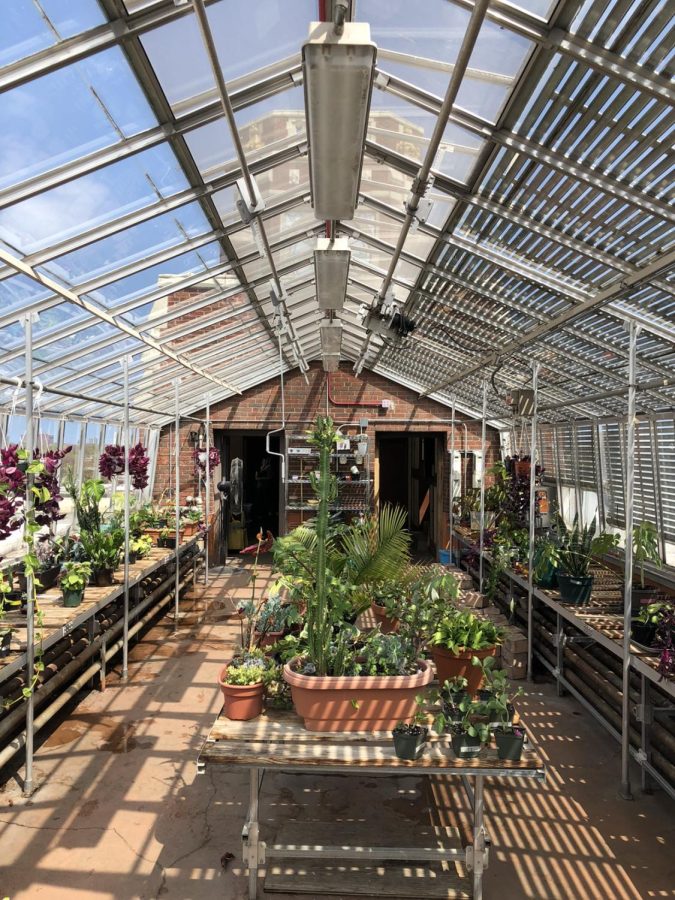Plants: an easier option for rejuvenation
Lane Tech’s Greenhouse filled and blooming after being barren during the pandemic.
Spring has finally sprung. After a winter that seemed to drag on for way too long, the trees have leaves, and daffodils are everywhere. Now people are able to venture out into nature and say goodbye to the damaging effects that linger after being forced to stay inside due to Chicago’s harsh winter weather.
This isn’t a new idea — that people thrive when surrounded by living things — but one that remains important.
Spending time in nature has been found by a Texas A&M University report to increase people’s vitality and promote positive outlooks on life, and considering the bleak perspectives that fester in winter and the seemingly endless succession of disastrous events occurring globally, that makes it all the more necessary. As well as this, spending time outside and surrounded by nature usually requires movement or physical activity, which also improves mental health.
However, depending on the weather for a mood boost is unreliable. This is where plants come in.
Having plants in one’s home is an excellent way to combat the issues presented by nature’s irregular availability because it holds many of the same benefits.
When people are around plants, the Texas A&M report says that they have better concentration, improved memory and a greater capacity to learn. Further, plants promote compassion, which in turn strengthens interpersonal relationships. Texas A&M reports that they even quicken the healing process because of their soothing effect, which is why they are often found in hospital rooms. On top of this, their presence in someone’s home reduces stress.
Part of a plant’s ability to do this is the act of taking care of the plant. This can happen at home, in someone’s garden or even at school, if you are a part of Lane’s horticulture class. Working with soil and living things and watching them grow is very soothing. To be able to take a step away from the fast paced bustle of life and slip into the gentler facet of life that is taking care of things can help people feel more settled.
“Just the process [of taking care of plants], I think some students really enjoy, and it is kind of like a break in their day from the pattern of other classes,” Lane Tech’s horticulture teacher, Kelly Heath, said.
This idea of a break from life is further echoed by one of the horticulture students, Axl Knickerbocker, Div. 352, who finds that repotting and taking care of plants at home gives him a good break from homework.
“It’s a good thing to spend time on,” he said.
Another good thing about plants is that because there are so many types with different needs, everyone can find one that works in their home. Heath has some recommendations for plants that are a good place to start for beginners.
“Snake plants are pretty hardy — sometimes called Mother in Law Tongues — they’re those big tall ones. And then there’s the Purple Zebra, which are pretty easy to grow and pretty forgiving. The Pothos is kind of slow-growing but also forgiving,” Heath said.
When a plant is forgiving, it means that even if you neglect the plant and it starts to wilt a bit, it can easily be brought back to life.
Snake plants also do not need a lot of light, which can be good for those whose homes do not have a lot of natural light.
Plants can become a social activity or at least a way to share joy with others. This is because once many plants have grown to a certain point and start producing babies, or sprouts, they can be cut and used to grow more plants and be given to others.
“If you’re at someone’s house, you’re like ‘Hey can I get a cutting of that?’ People are likely to say yes if you know what you’re doing and how to take care of them. So that’s the other great thing about plants, it’s easy to share with people,” Heath said.
Beyond plants being a positive force in people’s lives on their own, as they develop they can form connections between people.
“You can take them in for yourself and then give them away to people,” Knickerbocker said.
It’s a way of bringing people together over shared joy so that when life is a bit bleak, and going outside is limited, at least you have the plants and the people you share them with.
Your donations directly fund the Lane Tech student journalism program—covering essential costs like website hosting and technology not supported by our school or district. Your generosity empowers our student reporters to investigate, write, and publish impactful stories that matter to our school community.
This website is more than a publishing platform—it's an archive, a research tool, and a source of truth. Every dollar helps us preserve and grow this resource so future students can learn from and build on the work being done today.
Thank you for supporting the next generation of journalists at Lane Tech College Prep!

Saskia is a senior, this is her third year with the Champion. She loves writing and editing, and is planning to pursue a career in English. She spends...




